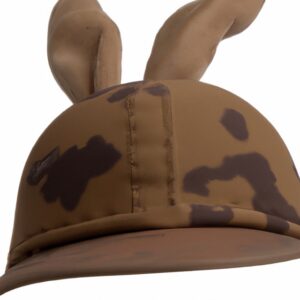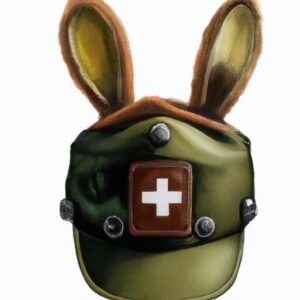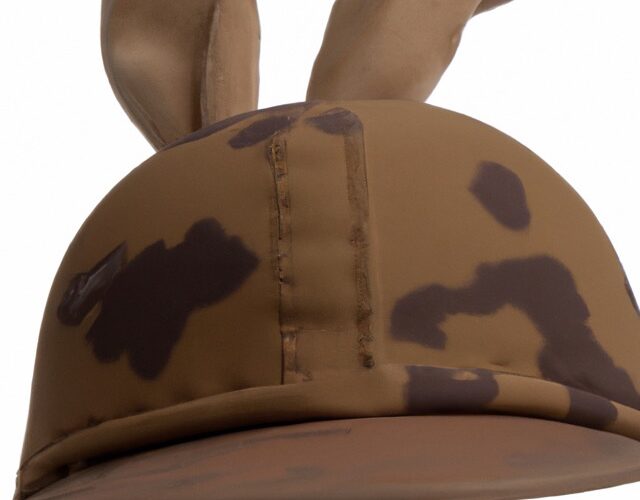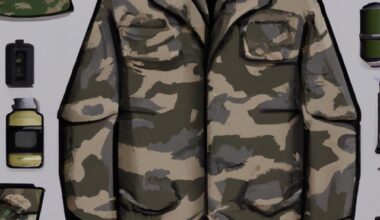Rabbit hunting is a popular activity for those looking to enjoy nature and bring fresh meat home to the family.
It’s important to have the right gear in order to successfully hunt rabbits, so it’s worth taking the time to make sure you have everything necessary before you set out.
This guide will provide an overview of essential rabbit hunting gear, offer guidance on navigable terrain, discuss various hunting regulations, and provide safety tips to ensure success.

Essential Rabbit Hunting Gear
Rabbit hunting requires the proper equipment for you to be successful. One of the most essential pieces of gear is a reliable firearm. Whether using a rifle, shotgun, or handgun, ensure that the gun is well-maintained and cleaned regularly.
Ammunition is also necessary and should match the caliber of your firearm. It is important to remember to use appropriate size rounds when hunting rabbits.
A scope can be very beneficial for rabbit hunting as it can increase the accuracy of your shots. Opt for one appropriate for the type of hunting you will be doing.
For increased camouflage and concealing yourself, camouflage clothing is highly recommended. This will make it easier to get close to rabbits without being detected.

Traps and Baits for Rabbit Hunting
When rabbit hunting, one key element to success is the use of the right traps and bait. There are many different types of traps used for rabbit hunting with their own unique advantages and disadvantages.
The most popular types of traps are snares, box traps, and netting. Each has its own purpose and should be used correctly to ensure a successful hunt.
For bait, rabbits prefer high-calorie foods such as oats and wheat. However, they can also be attracted by other tasty morsels like apples, carrots, and lettuce. Experimenting with different baits can help identify the best ones to use in any particular area.
Once a trap is set and baited, it is important to check it regularly. It is also important to limit access to other predators like cats and dogs – a cage or screen can help with this.
Finally, pay attention to local regulations to ensure that all trapping and baiting activities are conducted within the law.
Navigating the Terrain
When out hunting for rabbits, a hunter might encounter many different types of terrain. From wooded areas to open fields, each environment has its own advantages and disadvantages when it comes to hunting.
It is important to be aware of the terrain you are hunting in and how to find the best spots for pursuing rabbits.
When searching for rabbits, most hunters look for thick brush or tall grass. These areas provide a natural cover for the rabbits and are often more successful as hunting spots than open fields.
When scouting an area, look for signs of rabbit activity such as tracks, burrows, or droppings. This can help you determine where the rabbits might be hiding and serves as a good starting point.
Another factor to consider when hunting in different terrain is the wind direction. Most hunters will use the wind to their advantage by using it to cover their scent and move unnoticed. If the wind is blowing in your favor, you may be able to get closer to the rabbits without them detecting you.
By taking all these things into account, you will be able to determine the best area for hunting rabbits. With practice and experience, you’ll get better at recognizing the terrain and understanding which areas provide the greatest chances of success.
Binoculars and Spotlights for Rabbit Hunting
When it comes to hunting rabbits, having the right gear is essential. Binoculars and spotlights are two pieces of equipment that can greatly enhance your ability to spot rabbits in the field.
With binoculars, you can easily observe over long distances and identify different shapes, colors, and scents that a rabbit might leave behind. Spotlights also provide hunters with an advantage, as they can be used to search out rabbits at night when they are more active.
Binoculars provide a wide range of magnification levels, allowing users to easily pick out detail that might be hard to see with just the naked eye. This is especially important when hunting rabbits as they tend to blend into their surrounding environment.
By boosting the level of magnification, you can detect the slightest movements and colors that distinguish a rabbit from other animals and objects.
Spotlights provide a similar benefit, as they help to illuminate areas during the night and early morning hours when rabbits are most active. When using a spotlight, it’s important to be sure to remain still and quiet so as not to spook any rabbits that may be in the area.
Spotlights can also be used to scan large areas quickly, making it easier to locate potential targets.
By utilizing the right gear, such as binoculars and spotlights, you can make the most out of your next rabbit hunting trip. Remember to practice safe hunting techniques and be sure to follow all regulations and laws when out in the field.
Rural Hunting Regulations
When out hunting in rural areas, it is important to know and follow the local laws. Different states and regions may have their own specific regulations regarding the legalities of hunting rabbits, so it is essential to familiarize yourself with the rules and restrictions in the area before heading out.
A few common regulations include:
- The age requirements for hunting, which typically starts at 16 years old.
- Having the necessary permits or licenses obtained before hunting.
- Specified limits on the number of rabbits that can be taken.
- What type of firearms are allowed for rabbit hunting (e.g., shotguns, muzzleloaders, etc.).
- When and where hunting is allowed (such as certain hours, distance from dwellings, etc.).
- Whether traps are permitted and what types are acceptable.
It is also important to know that some areas may have additional regulations in place. When in doubt, it is best to contact the local game warden for more information.
Urban Hunting Regulations
Hunting rabbits in urban areas can be a great adventure, but also pose some potential risks. It is important to make sure that you understand and follow all of the necessary regulations set by the local municipality.
Different areas will have different rules, so it’s best to do your research ahead of time. In some cases, hunters may even need to obtain a special license to hunt in certain areas.
Make sure to check the specific regulations for when and where you are allowed to hunt. You should also be aware of any specific hunting restrictions in the area. It is important to be respectful of other urban dwellers, so only hunt when you have permission from the property owner.
Remember, it is always important to remain safe when out hunting. Make sure you alert nearby residents of your hunting activity and take all necessary safety precautions. When in doubt, always contact the local municipality for more information.
Rabbit Population Levels
When it comes to rabbit hunting, it’s important to be aware of the population levels of rabbits in the regions you hunt. Rabbits are a rapidly reproducing species and their numbers can fluctuate quickly. If the population of rabbits is low, then hunters must be especially mindful to avoid overhunting an area.
The population of rabbits can depend on a variety of factors, including climate, food availability, predation, and human activity. In areas with warmer climates, rabbits may be able to reproduce more quickly, leading to higher population levels.
In colder areas, the winter months can take a toll on the number of rabbits. Additionally, in areas with abundant food sources, rabbits will have greater success in reproducing and sustaining their population.
Predation from other animals, such as foxes, coyotes, and hawks, can also affect the population of rabbits. If these predators are present, their presence must be taken into account when assessing the local rabbit population.
Finally, human activities such as land-clearing for development or agriculture can have an effect, as it reduces the amount of habitat resources available to rabbits and other wildlife.
By staying informed on the current rabbit population levels of your hunting grounds, you can help ensure that the rabbit populations remain healthy. This will ensure that there are always plenty of rabbits to hunt, so all hunters can enjoy the sport.
Safety Precautions
When going out rabbit hunting, it is important to make sure that you take the proper safety precautions. These precautions can help keep you and your gear safe, as well as protecting the environment and other people in the area.
To stay safe while out hunting, be sure to:
- Wear the appropriate camouflage clothing to help you blend into your surroundings.
- Carry a whistle for emergencies or to scare away animals.
- Make sure you have a basic understanding of firearm safety and all necessary licenses.
- Check the area for any potential hazards, such as thick brush or bodies of water.
- Be aware of your surroundings at all times and avoid areas with other hunters.
By following these safety tips, you can ensure a safe and successful rabbit hunting experience.
Establishing a Hunting Strategy
When it comes to rabbit hunting, having an effective strategy can be the difference between success and failure. There are many different strategies available to hunters depending on the terrain, experience level, and local regulations. Below are some of the most common rabbit hunting strategies.
- Decoy Setups: Using decoys is a popular way to attract rabbits to a specific area. Setting up life-like decoys as close to their natural habitats as possible will increase the chances of a successful hunt.
- Stalking: Stalking involves moving stealthily through the woods in search of game. It’s important that the hunter move slowly and make as little noise as possible, so as not to scare away any potential targets.
- Calling: Calling is another great way to attract rabbits. As with decoy setups, using calls that are specific to the species will help increase the chances of a successful hunt.
Rabbit hunting requires patience and an understanding of the animal’s habits and behaviors. With the right strategy in place, the rewards will be worth the effort.
Proper Care & Storage of Equipment
Taking proper care of rabbit hunting gear is one of the key elements to being a successful hunter. Cleaning and maintaining firearms prevents them from jamming or malfunctioning during a hunt.
Camouflage clothing needs to be properly stored to minimize wear and tear, which can impact its effectiveness. Here are some tips for properly caring for and storing your equipment:
- Clean firearms after each use with a gun cleaning kit to remove lead and powder residue.
- Avoid storing firearms in direct sunlight as it can cause them to rust.
- Store camouflage clothing in a cool, dry place away from direct sunlight.
- Make sure to air out camouflage clothing after every hunt to prevent bacteria growth.
- Check traps regularly and clean them after each hunt to reduce the chance of disease spreading.
- Replace worn-out or broken equipment as soon as possible to prevent further damage.
Keeping your rabbit hunting gear properly stored and maintained will ensure that it’s always ready when you need it. Make sure to follow these tips to ensure your equipment is always in peak condition and will last for years to come!
Conclusion
Rabbit hunting is an enjoyable and challenging activity that can be enjoyed while out in the field. It is important to take the necessary precautions when out rabbit hunting and make sure to have the proper gear, like firearms, camouflage clothing, traps, baits and more.
Additionally, familiarize yourself with the hunting regulations of both the rural and urban areas you intend to hunt. By following the information provided in this guide, you can better prepare yourself for a safe and successful hunt.
FAQs on Rabbit Hunting Gear
1. What is rabbit hunting gear?
Rabbit hunting gear is specialized clothing, equipment and tools for individuals who engage in rabbit hunting. Such gear is meant to make rabbit hunting easier, comfortable and safer, increasing the chances of success.
2. What are some must-have pieces of rabbit hunting gear?
Some of the must-have pieces of rabbit hunting gear include hunting clothes, briar proof hunting gear, hunting boots, gloves, pants, vests, beagles, and hunting bibs.
3. What is briar-proof hunting gear?
Briar-proof hunting gear is equipment that is durable and specifically designed to protect hunters against sharp and prickly vegetation, protecting their clothes and skins while navigating through dense fields or marshy areas.
4. Why do I need briar proof hunting clothes?
Briarproof hunting clothes can protect you from the sharp edges of thorns and prickly bushes while hunting rabbits. When you brush up against briars, they can leave painful scratches on your skin or damage your hunting clothes.
5. How can a hunting dog help with rabbit hunting?
A hunting dog, such as a beagle, can help flush out rabbits, track them from scent, and retrieve them once they have been shot. They can also be used to locate rabbits that have not been spotted, helping to increase the hunter’s chances of success.
6. What are some popular brands of rabbit hunting gear?
Some of the popular brands of rabbit hunting gear include Dan’s hunting gear, Quack Attack, and featured products from reputable hunting gear companies.
7. How important is durable gear when rabbit hunting?
Durable gear is essential for rabbit hunting because it can withstand the wear and tear of the hunting environment and ensure that you do not have to replace gear frequently. Durable gear is also designed to provide maximum protection, helping the hunter stay comfortable and reducing the risk of injury.
8. What should I wear when hunting rabbits in cold weather?
When hunting rabbits in cold weather, you should wear insulated and waterproof hunting clothes, warm hats, and gloves. You may also require boots with thicker soles to protect your feet from the cold ground.
9. Is it necessary to wear orange clothing when rabbit hunting?
It is a legal requirement in most states to wear orange clothing when hunting small game, such as rabbits. Wearing orange clothing makes it easier for other hunters to spot you in the field, reducing the risk of accidents.


